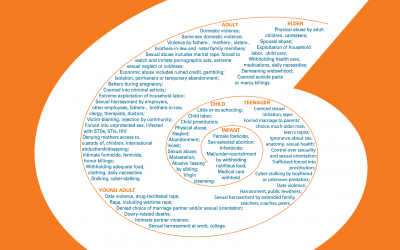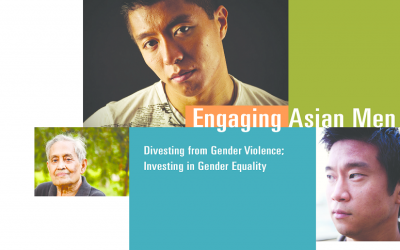We have come to understand cultures to be stable patterns of beliefs, thoughts, traditions, values, and practices that are handed down from one generation to the next to ensure the continuity of these systems. In fact, traditions actually shift and change under changing social and political landscapes. Culture does not reveal stable patterns, but dynamic ones where experiences and commonalities continually re-shape it.
It is important to shift our understanding away from totalizing culture to illustrating its diversity, contradictions, contrasts, ambiguities, and the interconnections between various internal systems that structure power
Related Resources
From Gender Violence to Gender Democracy: What Will It Take? 2011
How do we go from cultures of power and control to cultures of equality?
Lifetime Spiral of Gender Violence
The Lifetime Spiral reveals patterns of victimization by enumerating the types of violence, vulnerabilities, and harms women and girls face.
Engendering Change: Transforming Gender Roles in Asian & Pacific Islander Communities, 2007
This report asks and analyzes some critical questions, forcing us to take a hard look at all the factors that have to come together to effect transformation.
Lifecourse Experiences of Intimate Partner Violence and Help-Seeking among Filipina, Indian, and Pakistani Women, 2010
IPV often recurs over the lifecourse and survivors’ decisions to seek help are shaped by their history of positive and negative experiences of help-seeking, and because their preferred and actual sources of help change over time. Using the Life History Calendar to interview 143 Filipina, Indian and Pakistani domestic violence survivors, this research enhances our understanding of help-seeking over the lifecourse and makes recommendations for system responses to domestic violence in Asian communities.
Colonization and Violence against Women, 2002
By Val Kalei Kanuha
This talk explores the connection between colonization and patriarchy, and how this dynamic perpetuates gender violence.
Engaging Asian Men: Divesting from Gender Violence; Investing in Gender Equality, 2013
What will it take for men in our Asian communities to divest from gender violence and invest in gender equality?
Differing Dynamics of Domestic Violence in Asian Families: Implications for Child Custody Mediation, 2009
Cultural Defenses in the Criminal Legal System, 2002
By Leti Volpp
How leveraging cultural stereotypes in court plays into already existing negative depictions of culture.
What Does Cultural Competency Mean and Why Should I Care? 2007
By Sujata Warrier
Use these training slides to enhance understanding of culture and cultural competency in domestic violence agencies.
Gender and Culture in Transition: A Community Conversation: Report on Domestic Violence Forum with the Fresno Hmong Community, 2014
By Central California Asian Pacific Women.
Advocates and community members from Fresno convened to examine domestic violence within the context of gender equity and how it impacts Fresno’s Hmong community. Participants identified steps that communities and systems can take to raise awareness, improve service for survivors, and redefine gender values and practices.


